Causes of Decline in the Korean Fir Based on Spatial Distribution in the Mt. Halla Region in Korea: A Meta-Analysis
Abstract
1. Introduction
2. Material and Methods
2.1. Study Area
2.2. Mapping the Spatial Distribution of the Korean Fir
2.3. Distribution Map of the Accumulated Percent Mortality Rate for Korean Fir on Mt. Halla
2.4. Analysis of the Distribution Patterns of the Korean Fir
2.4.1. General Distribution of the Korean Fir
2.4.2. Analysis of the Altitudinal Distribution of the Korean Firs
2.4.3. Distribution of the Korean Fir Based on Aspect and Altitude
2.4.4. Comprehensive Analysis Regarding Distribution of Korean Fir in Areas with Heterogeneous Topography
2.5. Analysis of the Topographic Factors in the Distribution Area of the Korean Firs
3. Results
3.1. General Distribution of the Korean Fir on Mt. Halla
3.2. Distribution of the Korean Fir at Varying Altitudes
3.3. Distribution of the Korean Fir on Different Aspects
3.4. Distribution of the Korean Fir in Areas with Heterogeneous Topography
4. Discussion
4.1. Accumulated Percent Mortality Rate
4.2. Density
4.3. Density and Mortality Rate
4.4. Comprehensive Analysis Efforts Regarding the Distribution of the Korean Fir in Areas with Heterogeneous Topography
4.5. Proposal for the Distribution Area of the Korean Firs on Mt. Halla
5. Conclusions
Author Contributions
Funding
Acknowledgments
Conflicts of Interest
References
- National Institute of Forest Science (NIFS). Korea Fir Hallasan Mountain, Why Are They Dying? NIFS: Seoul, Korea, 2016. [Google Scholar]
- Wilson, E.H. Four new conifers from Korea. J. Arnold Arbor 1920, 1, 186–190. [Google Scholar]
- Kang, S.J. Regeneration process of subalpine coniferous forest in Mt. Jiri. J. Ecol. Environ. 1984, 7, 185–193, (In Korean with English abstract). [Google Scholar]
- Kim, E.S. Decline of Tree Growth and the Changes of Environmental Factors on High Altitude Mountains; Report no. KOSEF921-1500-081-2; Korea Science and Engineering Foundation: Seoul, Korea, 1994; (In Korean with English abstract). [Google Scholar]
- Park, W.-K.; Seo, J.-W. A Dendroclimatic Analysis on Abies koreana in Cheonwang-bong Area of Mt. Chiri, Korea. Korean J. Quat. Res. 1999, 13, 25–33, (In Korean with English abstract). [Google Scholar]
- Lee, C.-S.; Cho, H.-J. Structure and dynamics of Abies koreana Wilson Community in Mt. Gaya. Korean J. Ecol. 1993, 16, 75–91, (In Korean with English abstract). [Google Scholar]
- Lim, J.-H.; Woo, S.-Y.; Kwon, M.J.; Chun, J.H.; Shin, J.H. Photosynthetic capacity and water use efficiency under different temperature regimes on healthy and declining Korean fir in Mt. Halla. J. Korean For. Soc. 2006, 95, 705–710, (In Korean with English abstract). [Google Scholar]
- Koo, K.A.; Park, W.K.; Kong, W.S. Dendrochronological analysis of Abies koreana W. at Mt. Halla, Korea: Effects of climate change on the growths. Korean J. Ecol. 2001, 24, 281–288. [Google Scholar]
- Koh, J.G.; Kim, D.S.; Kim, J.G.; Ko, Y.J. Growth Dynamics of Korean Fir in Mt. Hallasan. Hallasan Res. Rep. 2015, 14, 9–26, (In Korean with English abstract). [Google Scholar]
- Moeslund, J.E.; Arge, L.; Bøcher, P.K.; Dalgaard, T.; Odgaard, M.V.; Nygaard, B.; Svenning, J.C. Topographically controlled soil moisture is the primary driver of local vegetation patterns across a lowland region. Ecosphere 2013, 4, 1–26. [Google Scholar] [CrossRef]
- Chaneton, E.J.; Lavado, R.S. Soil nutrients and salinity after long-term grazing exclusion in a flooding Pampa grassland. J. Range Manag. 1996, 49, 182–187. [Google Scholar] [CrossRef]
- D’Amore, D.V.; Hennon, P.E. Evaluation of soil saturation, soil chemistry, and early spring soil and air temperatures as risk factors in yellow-cedar decline. Glob. Chang. Biol. 2006, 12, 524–545. [Google Scholar] [CrossRef]
- Liu, H.; He, S.; Anenkhonov, O.A.; Hu, G.; Sandanov, D.V.; Badmaeva, N.K. Topography-controlled soil water content and the coexistence of forest and steppe in northern China. Phys. Geogr. 2012, 33, 561–573. [Google Scholar] [CrossRef]
- Silvertown, J.; Araya, Y.; Gowing, D. Hydrological niches in terrestrial plant communities: A review. J. Ecol. 2015, 103, 93–108. [Google Scholar] [CrossRef]
- Xiang, X.; Wu, X.; Chen, X.; Song, Q.; Xue, X. Integrating topography and soil properties for spatial soil moisture storage modeling. Water 2017, 9, 647. [Google Scholar] [CrossRef]
- Hennon, P.E.; D’Amore, D.V.; Schaberg, P.G.; Wittwer, D.T.; Shanley, C.S. Shifting climate, altered niche, and a dynamic conservation strategy for yellow-cedar in the North Pacific coastal rainforest. BioScience 2012, 62, 147–158. [Google Scholar] [CrossRef]
- Kim, G.; Choo, G. Comparison of growth condition of Abies koreana Wilson by districts. Korean J. Environ. Ecol. 2000, 14, 80–87. [Google Scholar]
- Song, K.M.; Kim, C.S.; Koh, J.G.; Kang, C.H.; Kim, M.H. Vegetation structure and distributional characteristics of Abies koreana forests in Mt. Halla. J. Env. Sci. Int. 2010, 19, 415–425. [Google Scholar] [CrossRef][Green Version]
- Song, K.M.; Kim, J.H. Vegetation change of long-term ecological research (LTER) site of Abies koreana forests in Hallasan mountain (Yeongsil area). J. Korea Soc. Env. Restor. Tech. 2018, 21, 1–12. [Google Scholar] [CrossRef]
- Kim, C.S. Characteristics of Distribution and Taxonomy of Abies Koreana; Report of Survey and Study of Hallasan Natural Reserve 2006; Research Institute for Mt. Halla: Jeju, Korea, 2006; pp. 451–471. [Google Scholar]
- Song, K.M. Vegetation Structure and Dynamics of Abies koreana Forests on Mt. Halla. Ph.D. Thesis, Jeju National University, Jeju, Korea, 2011; p. 97. [Google Scholar]
- Kim, N.S.; Lee, H.C. A study on changes and distributions of Korean fir in sub-alpine zone. J. Korea Soc. Environ. Restor. Technol. 2013, 16, 49–57. [Google Scholar] [CrossRef]
- Kim, J.K.; Koh, J.G.; Yim, H.T.; Kim, D.S. Changes of spatial distribution of Korean fir forest in Mt. Hallasan for the Past 10 Years (2006, 2015). Korean J. Environ. Ecol. 2017, 31, 549–556. [Google Scholar] [CrossRef]
- National Institute of Forest Science (NIFS). Status and Conservation of the Endangered Subalpine Coniferous Forests in Korea; NIFS: Seoul, Korea, 2019. (In Korean) [Google Scholar]
- Ahn, U.S.; Kim, D.S.; Yun, Y.S.; Ko, S.H.; Kim, K.S.; Cho, I.S. The inference about the cause of death of Korean Fir in Mt. Halla through the analysis of spatial dying pattern—Proposing the possibility of excess soil moisture by climate changes. Korean J. Agric. For. Meteorol. 2019, 21, 1–28. [Google Scholar] [CrossRef]
- Korea National Park Research Institute (KNPRI). Monitoring of Ecosystems Related to Climate Change in National Park, Korea; KNPRI: Wonju-si, Korea, 2018. (In Korean) [Google Scholar]
- Middleton, M.; Närhi, P.; Sutinen, R. Imaging spectroscopy in soil-water based site suitability assessment for artificial regeneration to Scots pine. ISPRS J. Photogramm. Remote Sens. 2011, 66, 287–297. [Google Scholar] [CrossRef]
- Jeju Special Self-Governing Province (JSS-GP). Jeju Province At A Glance; JSS-GP: Jeju-si, Korea, 2019. (In Korean) [Google Scholar]
- Bhattarai, K.R.; Vetaas, O.R. Variation in plant species richness of different life forms along a subtropical elevation gradient in the Himalayas, east Nepal. Glob. Ecol. Biogeogr. 2003, 12, 327–340. [Google Scholar] [CrossRef]
- Lomolino, M.V. Elevation gradients of species-density: Historical and prospective views. Glob. Ecol. Biogeogr. 2001, 10, 3–13. [Google Scholar] [CrossRef]
- Rahbek, C. The role of spatial scale and the perception of large-scale species-richness patterns. Ecol. Lett. 2005, 8, 224–239. [Google Scholar] [CrossRef]
- Dang, H.; Zhang, Y.; Zhang, K.; Jiang, M.; Zhang, Q. Age structure and regeneration of subalpine fir (Abies fargesii) forests across an altitudinal range in the Qinling Mountains, China. For. Ecol. Manag. 2010, 259, 547–554. [Google Scholar] [CrossRef]
- Ohsawa, M.; Nainggolan, P.H.J.; Tanaka, N.; Anwar, C. Altitudinal zonation of forest vegetation on Mount Kerinci, Sumatra: With comparisons to zonation in the temperate region of east Asia. J. Trop. Ecol. 1985, 1, 193–216. [Google Scholar] [CrossRef]
- Nakashizuka, T.; Yusop, Z.; Nik, A.R. Altitudinal zonation of forest communities in Selangor, Peninsular Malaysia. J. Trop. For. Sci. 1992, 4, 233–244. [Google Scholar]
- Shibata, O.; Ando, Y. Growth of Betula and Abies trees and their productivity at different altitudes in the subalpine zone. In Management of Structure and Productivity of Boreal and Subalpine Forests; Linder, S., Kellomäki, S., Eds.; Studia Forestalia Suecica: Uppsala, Sweden, 1993; Volume 191, pp. 21–24. [Google Scholar]
- Šrůtek, M.; Lepš, J.Š. Variation in structure of Larix olgensis stands along the altitudinal gradient on Paektu-san, Changbai-shan, North Korea. Arct. Alp. Res. 1994, 26, 166–173. [Google Scholar] [CrossRef]
- Lieberman, D.; Lieberman, M.; Peralta, R.; Hartshorn, G.S. Tropical forest structure and composition on a large-scale altitudinal gradient in Costa Rica. J. Ecol. 1996, 84, 137–152. [Google Scholar] [CrossRef]
- Pendry, C.A.; Proctor, J. Altitudinal zonation of rain forest on Bukit Belalong, Brunei: Soils, forest structure and floristics. J. Trop. Ecol. 1997, 13, 221–241. [Google Scholar] [CrossRef]
- Tang, C.Q.; Ohsawa, M. Zonal transition of evergreen, deciduous, and coniferous forests along the altitudinal gradient on a humid subtropical mountain, Mt. Emei, Sichuan, China. Plant Ecol. 1997, 133, 63–78. [Google Scholar] [CrossRef]
- Okitsu, S. Vertical distribution and structure of the tree vegetation in the montane forest of Mt. Pulog, Cordillera mountain range, the highest mountain in Luzon Is., Philippines. J. Veg. Sci. 1998, 15, 19–32. [Google Scholar]
- Sakai, A.; Matsui, K.; Kabeya, D.; Sakai, S. Altitudinal variation in lifetime growth trajectory and reproductive schedule of a sub-alpine conifer, Abies mariesii. Evol. Ecol. Res. 2003, 5, 671–689. [Google Scholar]
- Miyajima, Y.; Takahashi, K. Changes with altitude of the stand structure of temperate forests on Mount Norikura, central Japan. J. For. Res. 2007, 12, 187–192. [Google Scholar] [CrossRef][Green Version]
- DeLucia, E.H.; Smith, W.K. Air and soil temperature limitations on photosynthesis in Engelmann spruce during summer. Can. J. For. Res. 1987, 17, 527–533. [Google Scholar] [CrossRef]
- Körner, C. Alpine Plant Life: Functional Plant Ecology of High Mountain Ecosystems; with 47 Tables; Springer-Verlag: Berlin/Heidelberg, Germany, 2003. [Google Scholar] [CrossRef]
- Cohen, S.; Moreshet, S.; Guillou, L.L.; Simon, J.C.; Cohen, M. Response of citrus trees to modified radiation regime in semi-arid conditions. J. Exp. Bot. 1997, 48, 35–44. [Google Scholar] [CrossRef]
- Blanke, M.M. Photoinhibition in citrus–an invited review. Proc. Int. Soc. Citric. 2002, 9, 619–622. [Google Scholar]
- Raveh, E.; Cohen, S.; Raz, T.; Yakir, D.; Grava, A.; Goldschmidt, E.E. Increased growth of young citrus trees under reduced radiation load in a semi-arid climate. J. Exp. Bot. 2003, 54, 365–373. [Google Scholar] [CrossRef]
- Patrick, W.H.; Wyatt, R. Soil nitrogen loss as a result of alternate submergence and drying. Soil Sci. Soc. Am. J. 1964, 28, 647–653. [Google Scholar] [CrossRef]
- Morard, P.; Silvestre, J. Plant injury due to oxygen deficiency in the root environment of soilless culture: A review. Plant Soil 1996, 184, 243–254. [Google Scholar] [CrossRef]
- Wang, G.G.; Klinka, K. Use of synoptic variables in predicting white spruce site index. For. Ecol. Manag. 1996, 80, 95–105. [Google Scholar] [CrossRef]
- Wang, G.G. Use of understory vegetation in classifying soil moisture and nutrient regimes. For. Ecol. Manag. 2000, 129, 93–100. [Google Scholar] [CrossRef]
- Steffens, D.; Hutsch, B.W.; Eschholz, T.; Losak, T.; Schubert, S. Water logging may inhibit plant growth primarily by nutrient deficiency rather than nutrient toxicity. Plant Soil Environ. 2005, 51, 545–552. [Google Scholar] [CrossRef]
- Um, M.J.; Cho, W.C.; Rim, H.W. Rainfall adjustment on duration and topographic elevation. J. Korea Water Resour. Assoc. 2007, 40, 511–521. [Google Scholar] [CrossRef]
- Yun, H.S.; Um, M.J.; Cho, W.C.; Heo, J.H. Orographic precipitation analysis with regional frequency analysis and multiple linear regression. J. Korea Water Resour. Assoc. 2009, 42, 465–480. [Google Scholar] [CrossRef]
- Wang, T.; Liang, Y.; Ren, H.; Yu, D.; Ni, J.; Ma, K. Age structure of Picea schrenkiana forest along an altitudinal gradient in the central Tianshan Mountains, northwestern China. For. Ecol. Manag. 2004, 196, 267–274. [Google Scholar] [CrossRef]
- Bigler, C.; Gavin, D.G.; Gunning, C.; Veblen, T.T. Drought induces lagged tree mortality in a subalpine forest in the Rocky Mountains. Oikos 2007, 116, 1983–1994. [Google Scholar] [CrossRef]
- Van Mantgem, P.J.; Stephenson, N.L.; Mutch, L.S.; Johnson, V.G.; Esperanza, A.M.; Parsons, D.J. Growth rate predicts mortality of Abies concolor in both burned and unburned stands. Can. J. For. Res. 2003, 33, 1029–1038. [Google Scholar] [CrossRef]
- Stephenson, N.L.; Van Mantgem, P.J.; Bunn, A.G.; Bruner, H.; Harmon, M.E.; O’Connell, K.B.; Urban, D.L.; Franklin, J.F. Causes and implications of the correlation between forest productivity and tree mortality rates. Ecol. Monogr. 2011, 81, 527–555. [Google Scholar] [CrossRef]
- Das, A.J.; Stephenson, N.L. Improving estimates of tree mortality probability using potential growth rate. Can. J. For. Res. 2015, 45, 920–928. [Google Scholar] [CrossRef]
- Allen, C.D. Climate-induced forest dieback: An escalating global phenomenon. Unasylva 2009, 231, 43–49. [Google Scholar]
- Seo, J.-W.; Kim, Y.-J.; Choi, E.-B.; Park, J.-H.; Kim, J.-H. Investigation of death years and inter-annual growth reduction of Korean firs (Abies koreana) at Yeongsil in Mt. Halla. J. Korean Environ. Res. Technol. 2019, 22, 1–14. [Google Scholar] [CrossRef]
- Western, A.W.; Grayson, R.B.; Blöschl, G.; Willgoose, G.R.; McMahon, T.A. Observed spatial organization of soil moisture and its relation to terrain indices. Water Resour. Res. 1999, 35, 797–810. [Google Scholar] [CrossRef]
- Wilson, J.P.; Gallant, J.C. Terrain Analysis: Principles and Applications; John Wiley & Sons: Hoboken, NJ, USA, 2000. [Google Scholar]
- Qiu, Y.; Fu, B.; Wang, J.; Chen, L. Soil moisture variation in relation to topography and land use in a hillslope catchment of the Loess Plateau, China. J. Hydrol. 2001, 240, 243–263. [Google Scholar] [CrossRef]
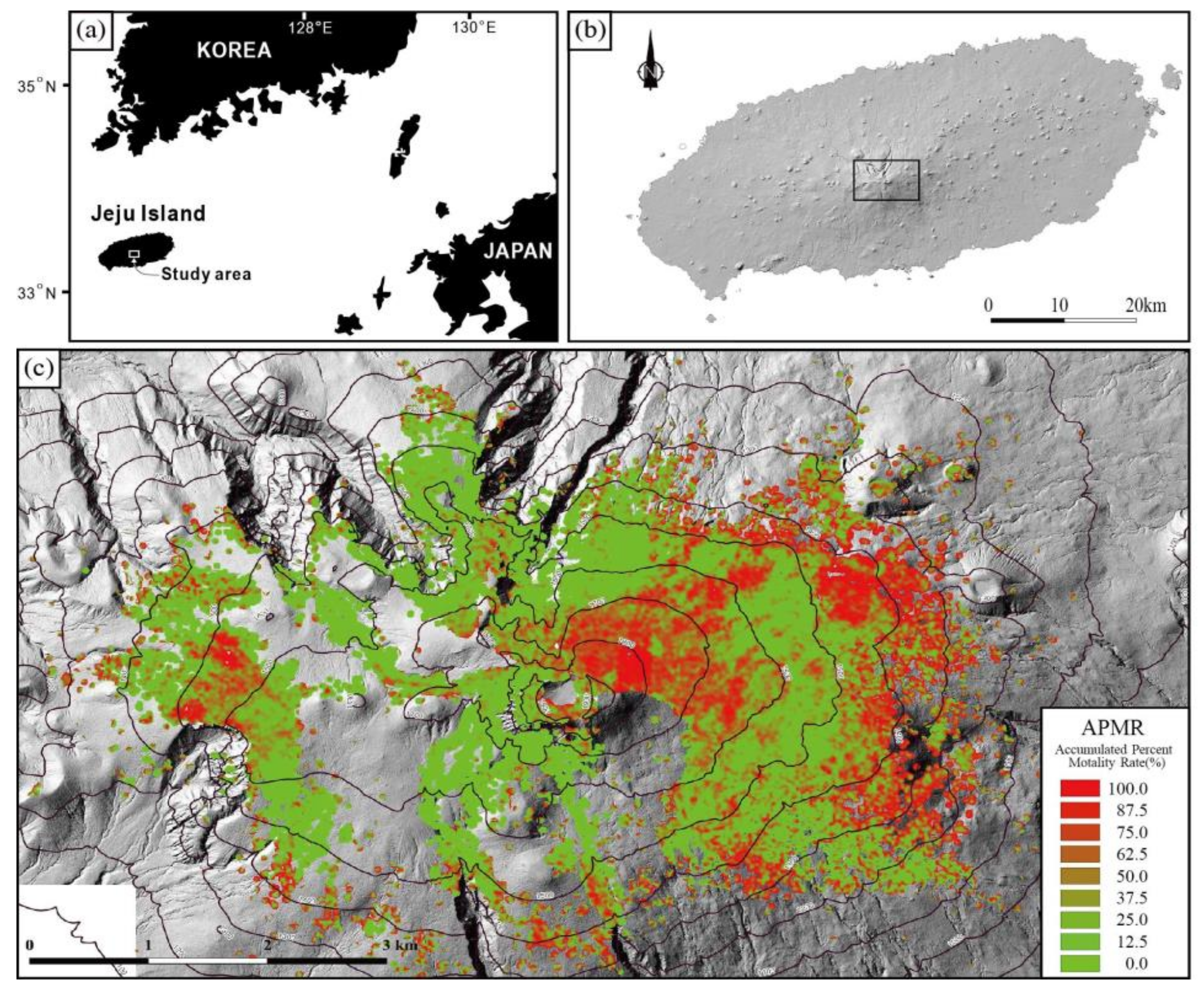
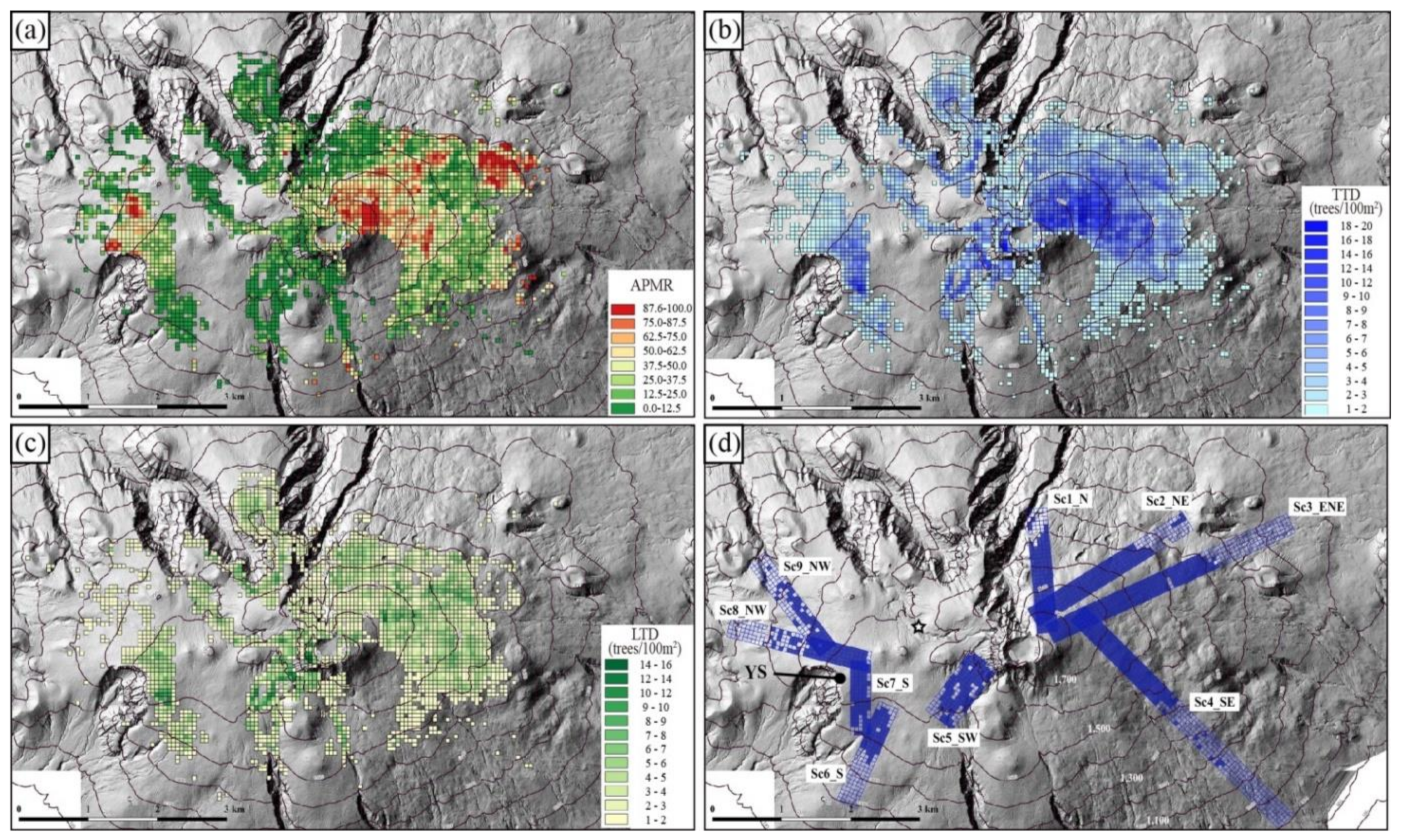

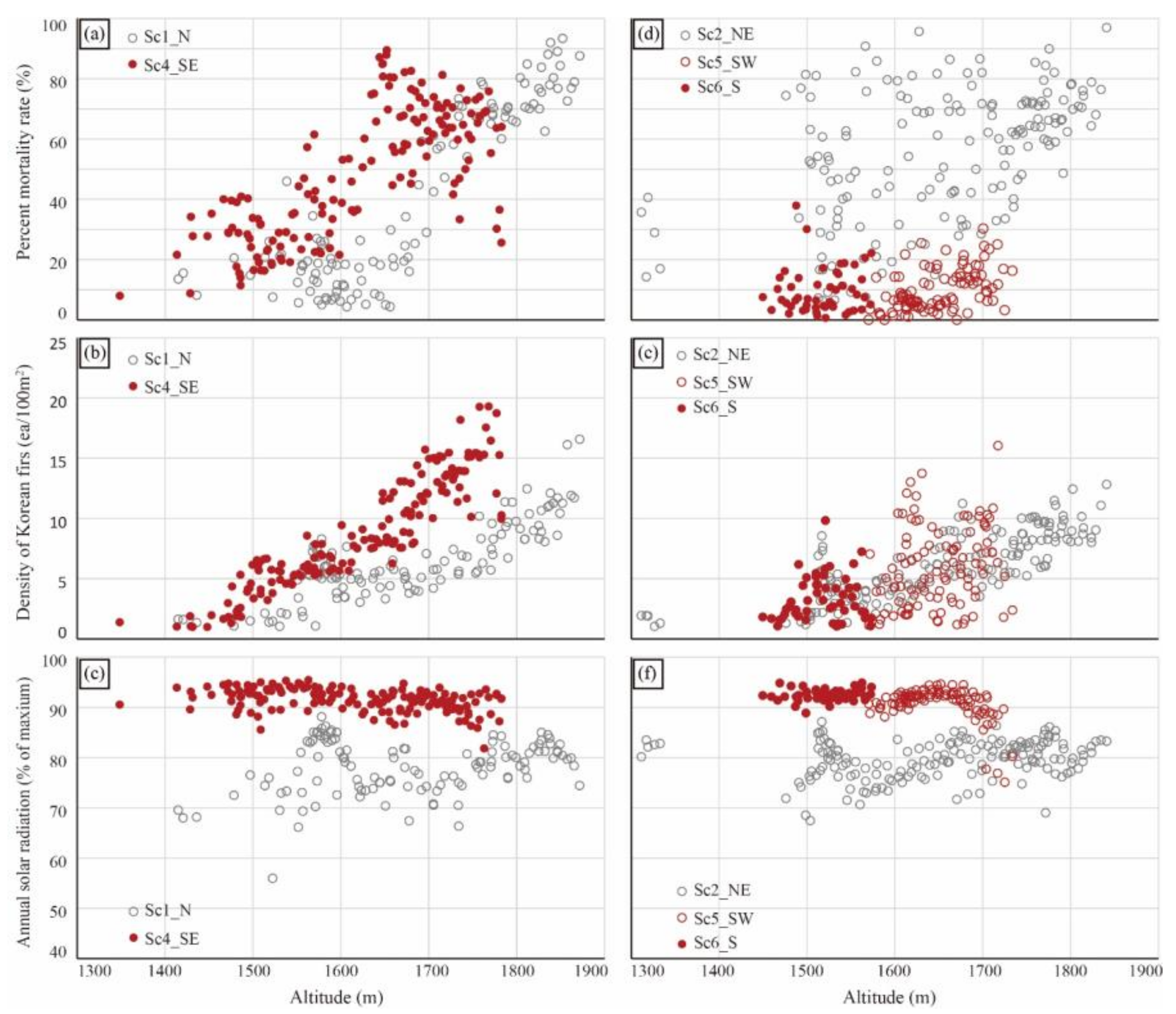

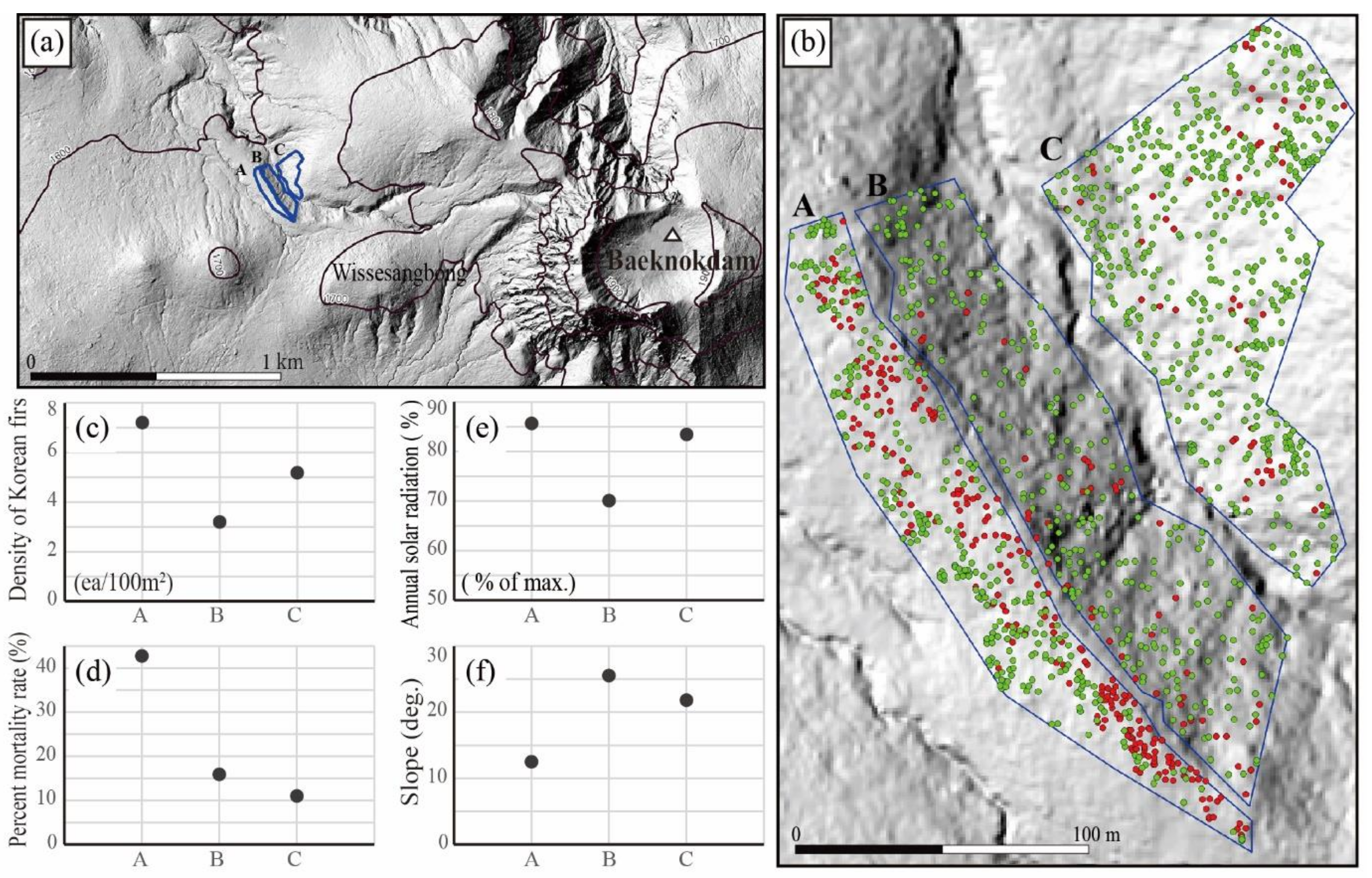
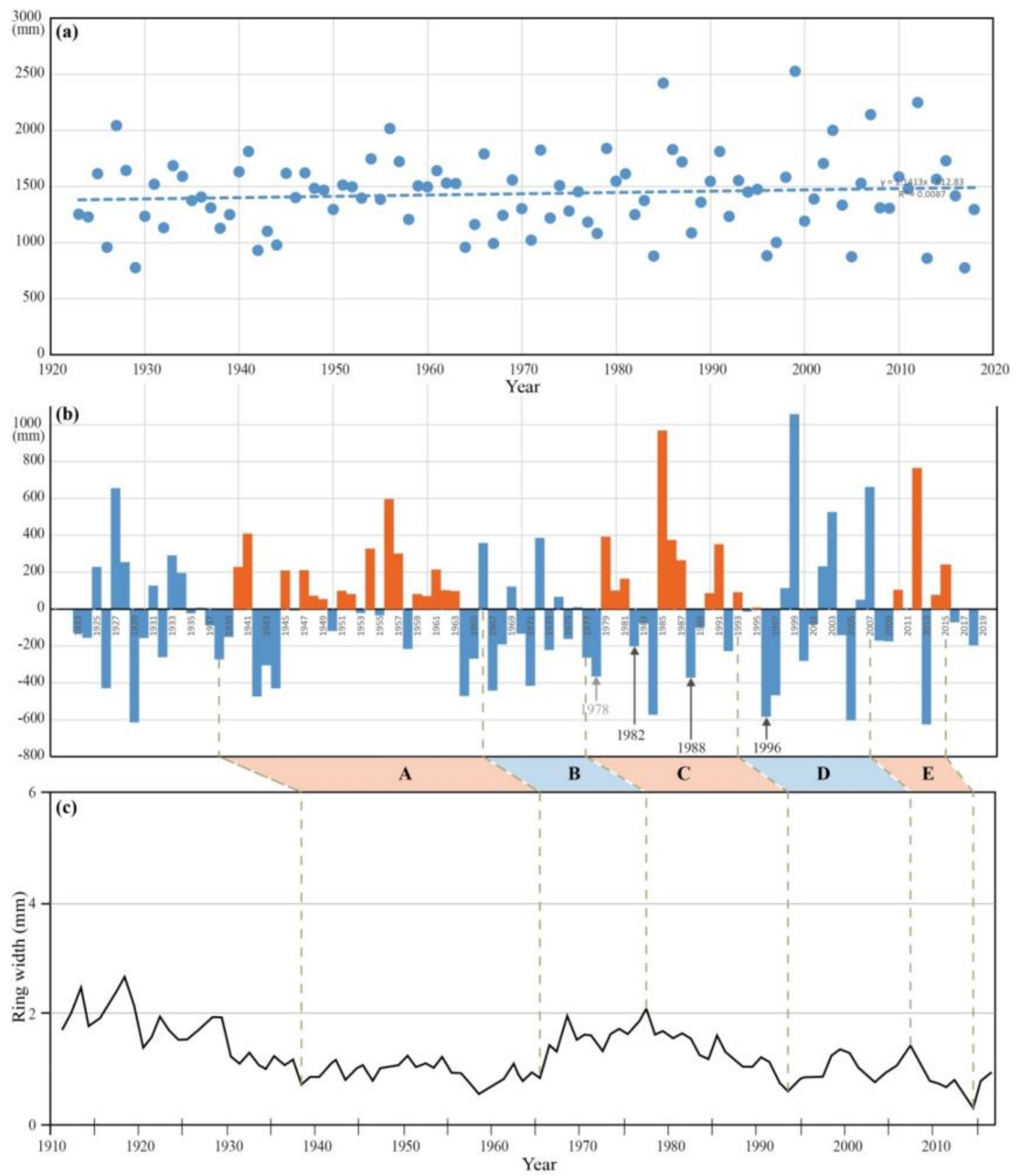
| No. of Cells | Area (ha) | No. of Total Firs | No. of Live Firs | No. of Dead Firs | Avg. APMR (%) | Avg. TTD (Trees/100 m2) | |
|---|---|---|---|---|---|---|---|
| Total analyzed cells | 15,300 | 5508.0 | 541,055 | 342,228 | 198,827 | 36.75 | |
| >36 trees/3600 m2 | 3075 | 1107.0 | 495,775 | 315,145 | 180,630 | 36.43 | 4.48 |
| <36 trees/3600 m2 | 12,225 | 4401.0 | 45,280 | 27,083 | 18,197 | 40.19 | 0.10 |
| No. of Live Firs | No. of Dead Firs | No. of Total Firs | APMR | Aspect | Slope | ASR | Altitude | |
|---|---|---|---|---|---|---|---|---|
| No. of live firs | 1 | 0.100 ** | 0.711 ** | −0.333 ** | −0.017 | −0.114 ** | 0.133 ** | 0.352 ** |
| No. of dead firs | 1 | 0.771 ** | 0.691 ** | −0.286 ** | −0.195 ** | 0.095 ** | 0.478 ** | |
| No. of total firs | 1 | 0.275 ** | −0.213 ** | −0.211 ** | 0.152 ** | 0.563 ** | ||
| APMR | 1 | −0.250 ** | −0.187 ** | 0.031 | 0.157 ** | |||
| Aspect | 1 | 0.103 ** | −0.078 ** | 0.027 | ||||
| Slope | 1 | −0.721 ** | 0.281 ** | |||||
| ASR | 1 | −0.195 ** | ||||||
| Altitude | 1 |
| Altitude Range (No. of Grid Cells) | t-Test for APMR | t-Test for TTD | ||||||||||
|---|---|---|---|---|---|---|---|---|---|---|---|---|
| ① Highest 50% APMR Range | ② Lowest 50% APMR Range | ΔAPMR_% (①-②) | Sig. | ① Highest 50% APMR Range | ② Lowest 50% APMR Range | ΔTTD_/100m2 (①-②) | Sig. | |||||
| Avg. APMR | SD | Avg. APMR | SD | Avg. TD | SD | Avg. TD | SD | |||||
| 1170–1937 m(3075) | 51.26 | 20.22 | 11.74 | 6.90 | 39.52 | 0.000 | 5.11 | 3.68 | 3.85 | 2.54 | 1.26 | 0.000 |
| Altitude range (No. of grid cells) | t-test for ground slope | t-test for ASR | ||||||||||
| ① Highest 50% APMR range | ② Lowest 50% APMR range | ΔSlope_deg (①-②) | sig. | ① Highest 50% APMR range | ② Lowest 50% APMR range | ΔASR_% (①-②) | sig. | |||||
| avg. slope | SD | avg. slope | SD | avg. ASR | SD | avg. ASR | SD | |||||
| 1170– 1937 m (3075) | 16.78 | 7.75 | 19.71 | 9.57 | −2.92 | 0.000 | 85.97 | 9.12 | 85.30 | 10.02 | 0.67 | 0.053 |
| Altitude Range (No. of Grid Cells) | t-Test for APMR Slope | t-Test for TTD | ||||||||||
|---|---|---|---|---|---|---|---|---|---|---|---|---|
| ① Highest 50% Density Range | ② Lowest 50% Density Range | ΔAPMR% (①-②) | Sig. | ① Highest 50% Density Range | ② Lowest 50% Density Range | ΔTTD_/100m2 (①-②) | Sig. | |||||
| Avg. APMR | SD | Avg. APMR | SD | Avg. TD | SD | Avg. TD | SD | |||||
| 1300–1900 m (3039) | 34.77 | 25.23 | 28.25 | 24.09 | 6.52 | 0.000 | 6.92 | 2.87 | 2.03 | 0.77 | 4.89 | 0.000 |
| Altitude range (No. of grid cells) | t-test for ground slope | t-test for ASR | ||||||||||
| ① Highest 50% Density range | ② Lowest 50% Density range | ΔSlope_deg (①-②) | sig. | ① Highest 50% Density range | ② Lowest 50% Density range | ΔASR_% (①-②) | sig. | |||||
| avg. slope | SD | avg. slope | SD | avg. ASR | SD | avg. ASR | SD | |||||
| 1300–1900 m (3039) | 16.52 | 7.46 | 19.97 | 9.71 | −3.46 | 0.000 | 86.63 | 8.08 | 84.64 | 10.79 | 1.99 | 0.000 |
| Altitude (m) | No. of Grid Cells (60 × 60 m) | No. of Korean Firs | Mean Percent Mortality Rate (%) | Mean Density of Korean Fir (Trees/100 m2) | ||
|---|---|---|---|---|---|---|
| Live | Dead | Total | ||||
| 1100–1200 | 3 | 159 | 21 | 180 | 11.67 | 1.67 |
| 1200–1300 | 11 | 333 | 143 | 476 | 30.04 | 1.20 |
| 1300–1400 | 89 | 2766 | 1902 | 4668 | 40.75 | 1.46 |
| 1400–1500 | 587 | 29,888 | 17,308 | 47,196 | 36.67 | 2.23 |
| 1500–1600 | 1123 | 118,807 | 34,584 | 153,391 | 22.55 | 3.79 |
| 1600–1700 | 804 | 105,190 | 55,658 | 160,848 | 34.60 | 5.56 |
| 1700–1800 | 316 | 42,328 | 48,610 | 90,938 | 53.45 | 7.99 |
| 1800–1900 | 120 | 10,635 | 20,606 | 31,241 | 65.96 | 7.23 |
| 1900–1950 | 22 | 5039 | 1798 | 6837 | 26.30 | 8.63 |
| Total | 3075 | 315,145 | 180,630 | 495,775 | 36.43 | 4.48 |
| Altitude Range (No. of Grid Cells) | t-Test for APMR | t-Test for TTD | ||||||||||
|---|---|---|---|---|---|---|---|---|---|---|---|---|
| ① Highest 50% APMR Range | ② Lowest 50% APMR Range | ΔAPMR_% (①-②) | Sig. | ① Highest 50% APMR Range | ② Lowest 50% APMR Range | ΔTTD_/100m2 (①-②) | Sig. | |||||
| Avg. MR | SD | Avg. MR | SD | Avg. TD | SD | Avg. TD | SD | |||||
| 1300–1400 m (89) | 70.87 | 17.42 | 16.69 | 13.56 | 54.17 | 0.000 | 1.28 | 0.31 | 1.64 | 0.83 | −0.36 | 0.009 |
| 1400–1500 m (587) | 54.44 | 22.20 | 12.83 | 7.65 | 41.61 | 0.000 | 2.40 | 1.27 | 2.07 | 1.26 | 0.33 | 0.001 |
| 1500–1600 m (1123) | 38.15 | 18.84 | 8.57 | 4.86 | 29.58 | 0.000 | 3.79 | 2.09 | 3.80 | 2.04 | −0.02 | 0.902 |
| 1600–1700 m (804) | 47.71 | 18.08 | 12.75 | 7.08 | 34.95 | 0.000 | 6.34 | 3.12 | 4.78 | 2.73 | 1.56 | 0.000 |
| 1700–1800 m (316) | 68.78 | 10.32 | 27.18 | 14.41 | 41.60 | 0.000 | 9.69 | 4.03 | 6.29 | 3.46 | 3.40 | 0.000 |
| 1800–1900 m (120) | 79.91 | 13.31 | 27.56 | 15.93 | 52.35 | 0.000 | 9.95 | 3.76 | 4.51 | 3.09 | 5.45 | 0.000 |
| Altitude range (No. of grid cells) | t-test for ground slope | t-test for ASR | ||||||||||
| ① Highest 50% APMR range | ② Lowest 50% APMR range | ΔSlope_deg (①-②) | sig. | ① Highest 50% APMR range | ② Lowest 50% APMR range | ΔASR (①-②) | sig. | |||||
| avg. slope | SD | avg. slope | SD | avg. ASR | SD | avg. ASR | SD | |||||
| 1300–1400 m (89) | 15.33 | 4.48 | 14.75 | 4.62 | 0.58 | 0.547 | 87.67 | 4.61 | 89.23 | 4.16 | −1.56 | 0.097 |
| 1400–1500 m (587) | 14.29 | 4.74 | 17.43 | 7.73 | -3.15 | 0.000 | 88.74 | 6.11 | 86.10 | 8.43 | 2.64 | 0.000 |
| 1500–1600 m (1123) | 16.12 | 5.65 | 19.71 | 9.46 | -3.60 | 0.000 | 86.98 | 7.49 | 84.93 | 10.36 | 2.05 | 0.000 |
| 1600–1700 m (804) | 16.53 | 8.68 | 19.55 | 8.86 | -3.02 | 0.000 | 86.31 | 10.11 | 85.21 | 10.34 | 1.10 | 0.128 |
| 1700–1800 m (316) | 16.92 | 7.71 | 25.21 | 11.08 | -8.30 | 0.000 | 84.97 | 9.74 | 81.89 | 11.95 | 3.08 | 0.012 |
| 1800–1900 m (120) | 19.00 | 6.04 | 34.94 | 12.89 | -15.95 | 0.000 | 81.99 | 7.18 | 73.36 | 14.50 | 8.62 | 0.000 |
| Altitude Range (No. of Grid Cells) | No. of Live Firs | No. of Dead Firs | No. of Total Firs | Aspect | Slope | ASR | Altitude |
|---|---|---|---|---|---|---|---|
| 1300–1400 m (89) | −0744 ** | 0.875 ** | −0.242 * | −0.651 ** | 0.153 | −0.298 ** | −0.027 |
| 1400– 1500 m (587) | −0.485 ** | 0.784 ** | 0.198 ** | −0.447 ** | −0.212 ** | 0.08 | −0.190 ** |
| 1500– 1600 m (1,123) | −0.428 ** | 0.718 ** | −0.075 * | 0.130 ** | −0.224 ** | 0.048 | −0.077 ** |
| 1600– 1700 m (804) | −0.316 ** | 0.839 ** | 0.361 ** | −0.390 ** | −0.191 ** | 0.052 | 0.202 ** |
| 1700– 1800 m (316) | −0.455 ** | 0.794 ** | 0.436 ** | −0.438 ** | −0.426 ** | 0.069 | 0.281 ** |
| 1800–1900 m (120) | −0.440 ** | 0.851 ** | 0.676 ** | −0.544 ** | −0.738 ** | 0.483 ** | −0.223 * |
| Altitude Range (No. of Grid Cells) | No. of Live Firs | No. of Dead Firs | APMR | Aspect | Slope | ASR | Altitude |
|---|---|---|---|---|---|---|---|
| 1300–1400 m (89) | 0.807 ** | 0.167 | −0.242 * | −0.054 | −0.048 | −0.008 | 0.161 |
| 1400–1500 m (587) | 0.683 ** | 0.630 ** | 0.198 ** | −0.254 ** | −0.300 ** | 0.204 ** | 0.227 ** |
| 1500–1600 m (1123) | 0.909 ** | 0.485 ** | −0.075 * | −0.247 ** | −0.353 ** | 0.232 ** | 0.201 ** |
| 1600–1700 m (804) | 0.714 ** | 0.699 ** | 0.361 ** | −0.246 ** | −0.475 ** | 0.324 ** | 0.138 ** |
| 1700–1800 m (316) | 0.510 ** | 0.840 ** | 0.436 ** | −0.464 ** | −0.600 ** | 0.506 ** | 0.113 * |
| 1800–1900 m (120) | 0.187 * | 0.916 ** | 0.676 ** | −0.447 ** | −0.591 ** | 0.342 ** | −0.114 |
| Site | Area (m2) | Number of Trees | Density of Korean Firs (Trees/100 m2) | APMR (%) | Mean Aspect | Mean Slope (deg.) | ASR (% of Max.) | Mean Altitude (m) | ||
|---|---|---|---|---|---|---|---|---|---|---|
| Dead | Live | Total | ||||||||
| A | 7174 | 221 | 296 | 517 | 7.21 | 42.75 | 258 | 12.5 | 85.6 | 1647 |
| B | 9622 | 49 | 259 | 308 | 3.2 | 15.91 | 59 | 25.5 | 70.1 | 1637 |
| C | 10,519 | 60 | 485 | 545 | 5.18 | 11.01 | 264 | 21.8 | 83.5 | 1629 |
| Year * | Area (ha) | Method of Calculation of Distribution Area of Korean Fir | Data Used for Determination of Distribution Area | Ref. |
|---|---|---|---|---|
| 2003 | 603.3 | Combining all the areas of each Korean fir stand around Mt. Halla (identified using aerial images). | non-orthorectified aerial images of 45 cm horizontal resolution | 20 |
| 2006 | 738.3 | Sum area of grid (15 × 15 m) with crown density > 10%. | orthorectified aerial images of 30 cm horizontal resolution | 23 |
| 2009 | 803.6 | Combining all the areas of each Korean fir stand around Mt. Halla (identified using aerial images). | orthorectified aerial images of 30 cm horizontal resolution | 21 |
| 2015 | 626.0 | Sum area of grid (15 × 15 m) with crown density > 10%. | orthorectified aerial images of 25 cm horizontal resolution | 23 |
| 2014 | 1508.0 | Sum area with crown density > 5%. | orthorectified aerial images of 10 cm horizontal resolution | 24 |
| 757.0 | Sum area with crown density > 10%. | |||
| 2017 | 928.8 | Sum area of grid (60 × 60 m) with tree density > 36 trees/3600 m2 by counting individual tree under digital photogrammetric system. | orthorectified aerial images of 8 cm horizontal resolution | This study |
| No. of Grid Cells | Area (ha) | No. of Total Firs | No. of Live Firs | No. of Dead Firs | Avg. APMR (%) | Avg. TTD (Trees/100 m2) | |
|---|---|---|---|---|---|---|---|
| Total analyzed cells | 15,300 | 5508.0 | 541,055 | 342,228 | 198,827 | 36.75 | |
| LTD > 36 trees/3600 m2 | 2579 | 928.4 | 456,192 | 304,178 | 152,014 | 33.32 | 4.91 |
© 2020 by the authors. Licensee MDPI, Basel, Switzerland. This article is an open access article distributed under the terms and conditions of the Creative Commons Attribution (CC BY) license (http://creativecommons.org/licenses/by/4.0/).
Share and Cite
Ahn, U.S.; Yun, Y.S. Causes of Decline in the Korean Fir Based on Spatial Distribution in the Mt. Halla Region in Korea: A Meta-Analysis. Forests 2020, 11, 391. https://doi.org/10.3390/f11040391
Ahn US, Yun YS. Causes of Decline in the Korean Fir Based on Spatial Distribution in the Mt. Halla Region in Korea: A Meta-Analysis. Forests. 2020; 11(4):391. https://doi.org/10.3390/f11040391
Chicago/Turabian StyleAhn, Ung San, and Young Seok Yun. 2020. "Causes of Decline in the Korean Fir Based on Spatial Distribution in the Mt. Halla Region in Korea: A Meta-Analysis" Forests 11, no. 4: 391. https://doi.org/10.3390/f11040391
APA StyleAhn, U. S., & Yun, Y. S. (2020). Causes of Decline in the Korean Fir Based on Spatial Distribution in the Mt. Halla Region in Korea: A Meta-Analysis. Forests, 11(4), 391. https://doi.org/10.3390/f11040391




